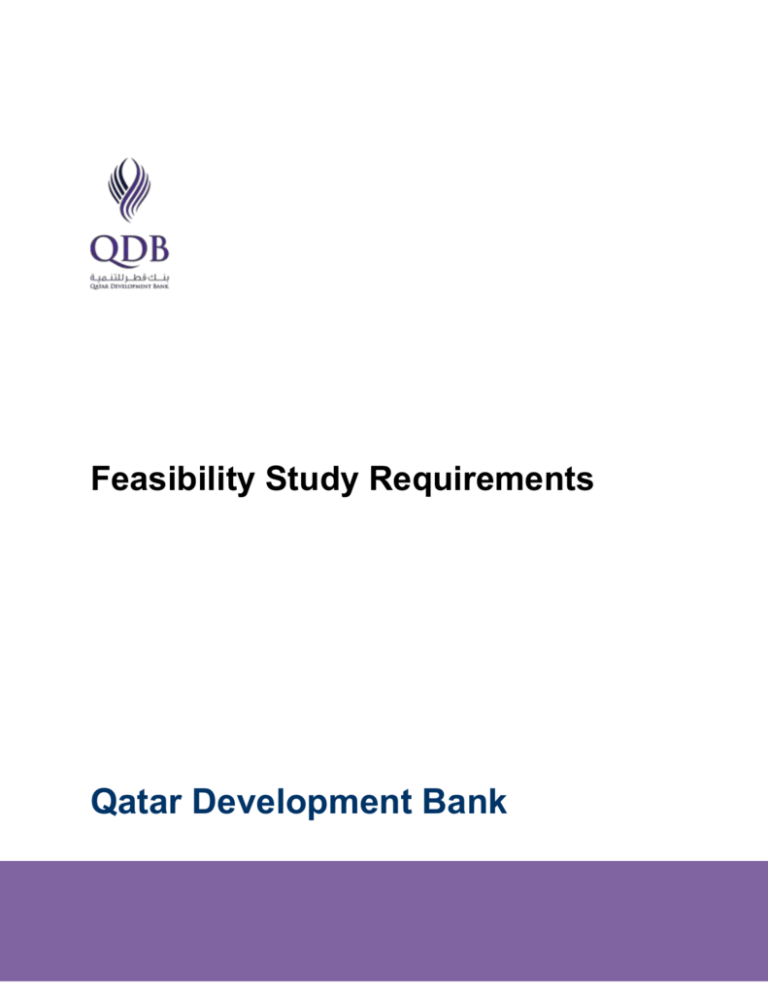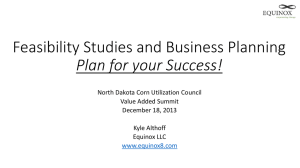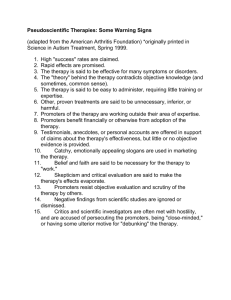Feasibility Study Requirements
advertisement

Feasibility Study Requirements Qatar Development Bank i. Feasibility Study Requirements The Feasibility study should ideally encompass the following areas / sections A. Executive Summary. B. Project details C. Promoters / Shareholders & Key Management review D. Macroeconomic and Industry Analysis E. Government Regulations F. Demand Supply analysis G. Marketing & Sales strategy H. Technology Review I. Franchise Agreements J. Detailed Financial Model K. Project Milestones and Implementation Plan L. Project Risks and Mitigants M. Conclusion & Recommendations N. Sources of Information & References to the database captured in Feasibility A detailed explanation / coverage of these elements provided in the following section. It is understood that all constituent parameters might not be applicable for all projects / sectors / businesses. The Service Provider / Consultant is expected to apply diligence in structuring the study appropriately as per applicability of guidelines / parameters relevant to the Project. Page 2 of 8 ii. Explanation of elements of the feasibility study report A. Executive Summary a) Explanation of the concept / business idea (Description of the Project & Products, Quality, features etc ) b) Reasons and rationale for selecting particular business concept/ idea c) Competitive Advantage of the Product when compared to the existing players in the market / imported products B. Project details a) Site Location, Area, Land details, space requirements, layouts etc b) Description of the Machineries required, its sources, Cost, Specifications etc (provided Quotations for Machineries) c) Construction details like Area, Cost, Construction period etc d) Total Capacity of the Plant e) Components of the Raw Materials, Sources and how they will be sourced f) Working Capital Requirements g) Total Cost of the Project h) Debt requirement i) Shareholder’s Capital & details regarding sources of Capital j) Key Financial Parameters of the Group (if any) Page 3 of 8 C. Promoters / Shareholders & Key Management review a) Names and details of the Promoters / shareholders b) Experience as an entrepreneur (including Proposed line of Business) c) Capabilities and educational / vocational qualifications d) Involvement in operations e) Key Staff Requirements & their capabilities / specializations f) Availability of Skilled Workers & their source of recruitment - Locally or Overseas (applicable for industries where highly skilled, technical, professional employees are required) g) Financial strength and Personal Net Worth of the Promoters D. Macroeconomic and Industry Analysis a) Market Potential and expected market growth over a 5 year horizon (based on realistic / grounded estimates) b) Analysis of macroeconomic factors applicable to the project and impact of such factors on the sustainability / viability such as impact of foreign exchange regulation, interest rates, threat of imports c) Industry analysis including analysis on the following: − Key growth drivers and deterrents for the industry selected − Major trends & Market size − Threat of new Entrants & their Entry barriers − Threat of Substitutes, Bargaining Power of Buyers & Suppliers − Industry characteristics encompassing seasonality, industry life cycle etc Industry Analysis Models like “Porter’s Five Forces model” may also be used as a tool for Industry Analysis. Page 4 of 8 E. Government Regulation a) Applicable government / market regulations (permits, licenses and other regulatory requirements) for set up / expansion b) Environment issues F. Demand-Supply analysis a) Present Market demand & supply of the Product – quantitative details b) Import & Export quantitative details of the Product c) Projected growth in the market and the corresponding basis of projection d) Existing Suppliers in the Market (including Foreign suppliers), Capacity & their Market share for the Product e) Target Clients f) Export competitiveness of the firm g) Supplier and Customer credit terms G. Marketing & Sales Strategy a) Marketing & Promotion b) Customer Retention policy c) Distribution channels H. Technology review a) Details on proposed technology / machine / equipment to be used b) Details on Technology provider e.g. global leader / local / Chinese etc. c) Technology changes and risk of technology getting obsolete Page 5 of 8 d) Risk of Inventory Obsolescence e) Plan for technical maintenance & upgradation (e.g. Service Level Agreements) and Degree of support available from technology collaborator (troubleshooting / maintenance / SLAs) f) I. Describe the manufacturing process Details of Franchise arrangement a) Applicable franchising fees (upfront fees and royalty) b) Level of support from franchisor J. − Set up (equipment, infrastructure, staff, capacity planning) − Training − Marketing & Sales support − Quality Control Detailed Financial Model a) Typically, the financial model would comprise the tabs as illustrated below. The forecast horizon is 10 years and must apply to all applicable items mentioned: − Revenue assumptions − Cost assumptions − Debt Repayment Schedule − Depreciation Schedule (include useful life of Assets) − Capital Investment Schedule (Project investment and additions) including Land, Buildings, Plant & Equipment, Furniture & Fixtures and Pre-operative Expenses − Dividend Policy Page 6 of 8 − Forecasted Financial Statements based on 10 year forecast horizon: Income Statement, Balance Sheet and Cash flows − Project appraisal indicators (IRR, Payback Period, NPV) − Forecasted Project Ratios (Performance, Liquidity, Solvency, Turnover, Leverage) (The following ratios must be covered: Debt Service Coverage Ratio, Interest Cover Ratio, Total Liabilities to Net Worth, Interest Bearing Debt to Net Worth, Cash Conversion Cycle and Performance ratios) − Sensitivity analysis (Impact on gross profit ratio, net profit ratio, cash flows, IRR and payback period based on 5%, 10% and 15% variation in revenue, direct costs and indirect costs − Assumptions used in Financial model b) The constituent revenue and cost estimates would need to be detailed out as follows: − Revenue estimates (assumptions and projections) (1) Define individual Revenue streams for the project (2) Estimated volume of products to be sold and corresponding rationale (3) Product wise Selling Price (4) Growth in y-o-y volume (5) Break up of Cash sales & Credit Sales − Expense assumptions and estimates (1) Direct costs (a) Material cost/ Raw material cost (include volumes also) (b) Stores and spares (c) Employee cost (direct) (d) Power and utilities (e) Factory Land Rent etc (2) Indirect costs Page 7 of 8 (a) General and Admin (b) Salaries (list of employees needed, category, salary levels) (c) Office Rent etc. (3) Working capital requirement (a) Inventory (b) Debtors (c) A/c payables K. Project schedule and milestones/ implementation plan a) Detailed step wise implementation plan with defined timelines and in built contingencies. b) Key linkages and dependencies of different implementation steps L. Project Risks and Mitigants a) Identify key risks for the project which could significantly impact the set up / commissioning and startup f the project b) Identify other risks applicable at market and operational level c) Define risk mitigants planned to overcome these risks M. Conclusion & Recommendations N. Sources of Information & References to the database captured in Feasibility Page 8 of 8







